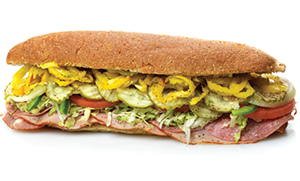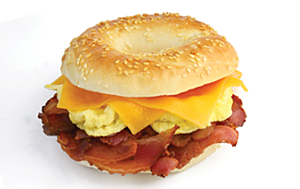Convenience-store foodservice sales took a big hit during the pandemic and lockdowns of 2020, but the unprecedented situation also gave the industry an opportunity. “We were an essential business, and if you needed anything, you could come to us, fuel up and grab a bite,” said Matt High, senior category sales manager for made to order, Sheetz. “We’ve had a wonderful opportunity to have people who’ve never eaten at a convenience store to come through our doors.”
We’re on the doorstep of the strong, summer season.
Fortunately, monthly sales of prepared c-store foods rebounded to above pre-pandemic levels in 2021, according to Jayme Gough, research manager, NACS. “This is a function of workers going back into the office, waning concerns around COVID-19 and an increasingly ‘back to normal’ way of life for many people,” she said.
In 2021, prepared food accounted for 13.78% of in-store sales, which was 1.43 points higher than 2020, and brought in $302,346 in average sales per store, up 21.3% from 2020, according to the NACS State of the Industry Report of 2021 Data. Prepared food contributed 69.5% of foodservice category sales in 2021.
RETHINKING MENUS
Everyone was forced to adapt to the changes brought about by the pandemic. Last year, many c-store operators pared down their foodservice selections to make menus more manageable. But recently, they are beefing up options once again.
 Source: NACS State of the Industry Report of 2021 Data
Source: NACS State of the Industry Report of 2021 Data
“We made significant cuts to focus on our core menu and execution,” said Ben Hoffmeyer, vice president, marketing and merchandising, TXB Stores. “This year, we’ve returned to our limited time offer schedule. We’ve introduced several new items, including Chicken Poppers— original or spicy. We use our current chicken tenders and cut them to create a snacking option that leverages our new packaging. It’s a great way of taking an existing item, re-imagining it and still retain operational execution.”

The Texas-based chain also uses chicken tenders in its enchiladas, available hot or as a take-and-heat option. “Not only does the customer get a great tasting product, but TXB can lower waste and increase profitability,” Hoffmeyer said. “And the enchilada plates in the cold case are SNAP EBT eligible, which allows us to hit another customer segment.”
Early this year, Ankeny, Iowa-based Casey’s rolled out the Toastwich, a hand-held sandwich of made-from-scratch pizza dough and traditional breakfast fixings, such as eggs, bacon, sausage and cheese. “It’s highly craveable, it’s highly portable, it’s value priced and it’s something unique that you can’t get anywhere else,” said Darren Rebelez, president and CEO, Casey’s. Along with the Loaded Breakfast Bowl and Loaded Breakfast Burrito, which the chain added last year, the Toastwich has revived interest in Casey’s morning menu. In March, Casey’s announced that breakfast daypart same-store sales were up 17% from the same period a year ago.
Simplicity and ease of implementation are essential for small- to mid-size c-stores that may be limited in staffing.
As more guests return to their daily commutes and outside-the-home activities, traffic for convenience stores will only grow,” said Richard Guidry, director, food and beverage, Casey’s. “We’re on the doorstep of the strong, summer season. Curbside and third-party delivery offerings only add to the convenient options for our guests to get Casey’s delicious food.”
BRANDED PROGRAMS
A successful foodservice program involves more than just managing a menu, and not every convenience operator has the time, energy or resources to create a proprietary program from scratch. A well-planned program requires procedures for dealing with food safety, managing waste and training employees, while creating advertising and promotions. To go directly to ringing sales and serving customers, many chains prefer to bring one or more turnkey foodservice programs in store.
“We’ve pressure-tested thousands of products and procedures, conducted due diligence on multiple equipment manufacturers, negotiated competitive pricing with suppliers, built a reliable supply chain network and created a nationally recognized brand,” said William Culpepper, vice president, marketing, Chester’s Chicken, a fried chicken program currently available in 1,200 locations, offering chicken pieces and sandwiches, plus dipping sauces and sides.
 Source: CSX LLC; csxllc.com
Source: CSX LLC; csxllc.com
“To do all of those things from scratch would be a massive undertaking in time, money and resources for any organization,” he said. “When stores partner with a brand like Chester’s, we’ve already done all of the heavy lifting, which means that our operators can simply focus on executing and driving sales to their location.”
Innovation is critical.
Dee Cleveland, director of marketing, Hunt Brothers Pizza, said, “Foodservice programs can add significant value and profit to any c-store operation. However, it’s essential for c-stores to do their research ... before they dive into a partnership.” The turnkey Hunt Brothers Pizza program is in 8,000 convenience stores in 28 states.
“Simplicity and ease of implementation are essential for small- to mid-size c-stores that may be limited in staffing,” Cleveland said. “Hunt Brothers sets up c-stores for success by offering kitchens that require little space. Our 59-square-foot kitchen option allows stores to offer both grab-and-go and made-to-order pizzas all day.”
Established turnkey programs come with an existing customer base, brand recognition and post-startup assistance to help the operator remain profitable.
 Source: NACS State of the Industry Report of 2021 Data
Source: NACS State of the Industry Report of 2021 Data
“After learning to cook and serve the program, often the biggest learning curve is managing inventory cost and margin,” said Dan Shaprio, CEO, Krispy Krunchy, a Cajun-style fried chicken program available in more than 2,600 retail locations nationwide. “Foodservice must be set up to accurately consider the component costs that contribute to each menu item, such as packaging and food cost, and the retail price for that menu item. Otherwise, the operator is at risk of eroding retail price due to incorrect ringing at the register or significant shrink.”

Producing quality foods on site has become de rigueur for convenience stores, and “innovation is critical.
In fact, it’s almost as critical for the convenience industry as it is for a tech company,” said High of Sheetz.
To win in the world of convenience-store foodservice, “don’t fall in love with a product, a process or a price,” he said. “Listen to your customers and meet their needs. That’s fundamental in this business. If we’re unwilling to change, we’re going to miss some golden opportunities.”
The Power of CSX Data

CSX, the engine behind category metrics and NACS State of the Industry data, provides current and customizable tools for financial and operational reporting and analysis in the convenience industry. Retailers can measure their company by any of the myriad metrics generated via our live database. Contact Chris Rapanick at (703) 518–4253 or crapanick@convenience.org for a complimentary executive walkthough.